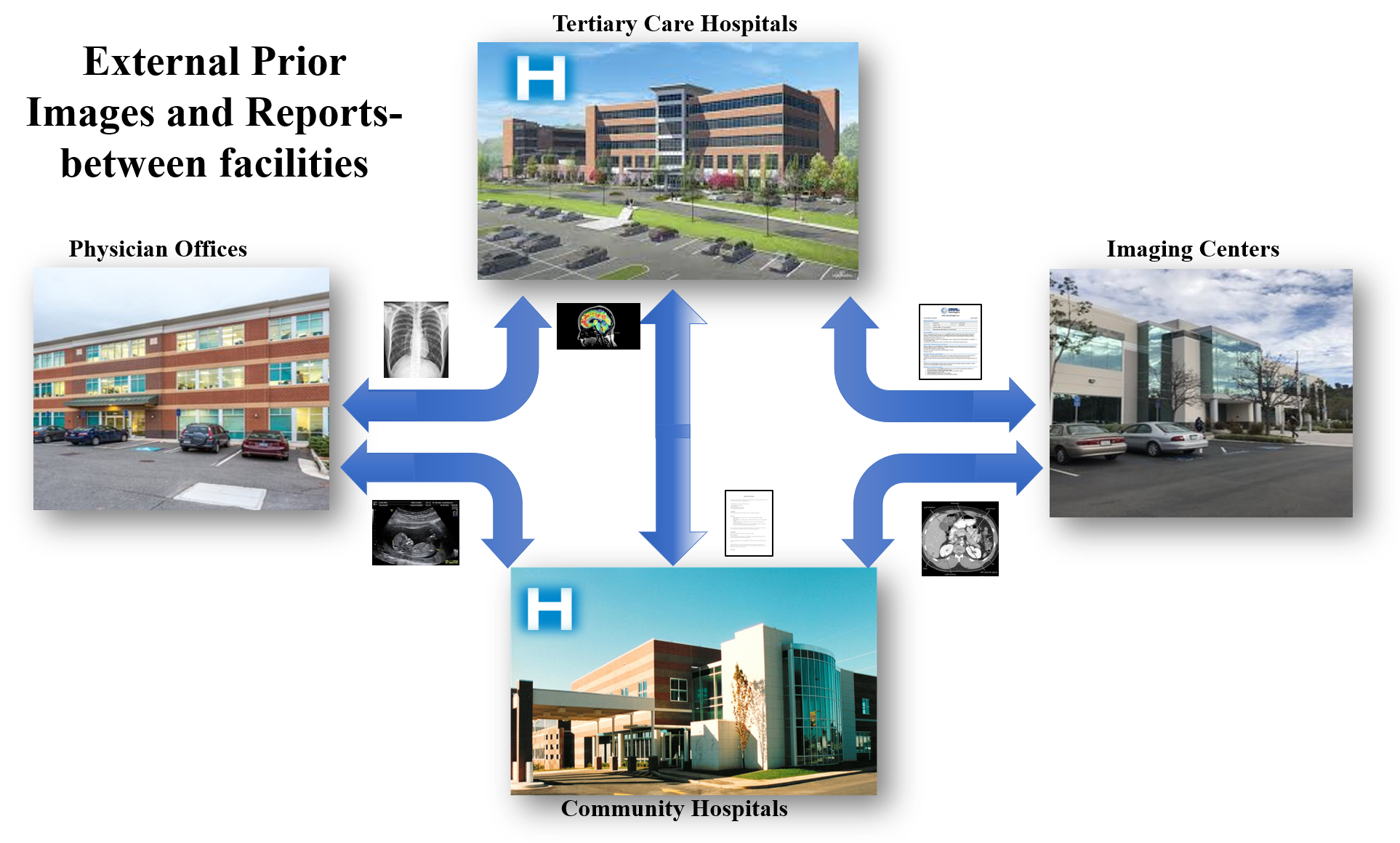Difference between revisions of "Import and Display of External Priors"
(Initial placeholder draft) |
(→Summary: Added summary) |
||
| Line 4: | Line 4: | ||
==Summary== | ==Summary== | ||
| − | + | It is common for patients to move between healthcare facilities that serve a shared patient population. Many of these healthcare facilities already have a shared secure network | |
| + | infrastructure. Upon receipt of an order for a new imaging study, the IHE Radiology Import and Display of External Priors (IDEP) Profile provides a method to automatically retrieve images and reports throughout the shared network, independent of a common Patient Identifier. The exchange includes “localizing” the data such that both the radiology images and reports may be displayed in the same system in the expected manner for side-by-side comparison and report display. | ||
| − | + | [[Image:IDEP_Intro_Diagram.png | center | 800px | Flow of external prior images and reports between facilities]] | |
| − | |||
| − | |||
==Benefits== | ==Benefits== | ||
Revision as of 09:39, 26 July 2019
Import and Display of External Priors (IDEP) specifies the trigger events, transactions, and data mappings necessary to automate the discovery of relevant prior imaging studies and reports and the transfer between different facilities, i.e., “external priors”.
Summary
It is common for patients to move between healthcare facilities that serve a shared patient population. Many of these healthcare facilities already have a shared secure network infrastructure. Upon receipt of an order for a new imaging study, the IHE Radiology Import and Display of External Priors (IDEP) Profile provides a method to automatically retrieve images and reports throughout the shared network, independent of a common Patient Identifier. The exchange includes “localizing” the data such that both the radiology images and reports may be displayed in the same system in the expected manner for side-by-side comparison and report display.
Benefits
<If the profile can improve Cost, Safety, Quality or Efficiency then list the specific examples of that benefit (e.g. error reduction, increased throughput) and how they come about (e.g. SWF reduces patient errors due to mistyped demographics at the modality by transfering demographics electronically from the Order Filler). Consider using a bullet list for readability. Such benefits help users and vendors make the business case for the profile. If the profile does not improve any aspect of Cost, Safety, Quality or Efficiency feel free to talk about something else here.>
Details
<A few paragraphs, if appropriate, providing more details (mostly in user-speak, not tech-speak) on what the profile does and how it works.>
<If the user might be familiar with the mechanisms used by the profile, you can mention them here. E.g. Evidence Documents is based on DICOM Structured Report (SR) Templates.>
<If the user might have an appreciation for the problems addressed in the profile, you can mention them here, but keep it short. E.g. Mapping HL7 Order fields to DICOM Modality Worklist attributes can be inconsistent in the marketplace, so Scheduled Workflow provides vendors with more detailed instructions.>
Systems Affected
<List (in user terms) the types of systems they might expect to have implemented actors from this profile, e.g. RIS, PACS, HIS, CAD Workstation, etc. and for each, how it would participate.>
- PACS systems may store, manage, and/or display Evidence Documents.
- Display systems may query, retrieve and display Evidence Documents.
- Reporting workstations may retrieve, process and include details from Evidence Documents in reports
Actors & Transactions:
<Insert an actor-transaction diagram, and or list of Content Definitions>
Specification
Profile Status: Trial Implementation
Documents:
Underlying Standards:
See Also
Related Profiles
<List profiles this one depends on, profiles that depend on this one, profiles that are synergistic with this one. Start with the name of the other profile as a link and then explain the relationship.>
- Reporting Workflow [RWF] may use Evidence Documents as inputs to the reporting process.
- Simple Image & Numeric Reports [SINR] may include data copied from Evidence Documents.
- Cross-enterprise Document Sharing for Imaging [XDS-I] can be used to share Evidence Documents between sites over a network.
- Portable Data for Imaging [PDI] can store Evidence Documents on media such as CDs.
- Import Reconciliation Workflow [IRWF] can fix patient ids, etc. of Evidence Documents when importing.
Consumer Information
The Profile FAQ Template answers typical questions about what the Profile does. <Replace the link with a link to the actual FAQ page for the Profile>
The Profile Purchasing Template describes considerations when purchasing equipment to deploy this Profile. <Replace the link with a link to the actual Purchasing page for the Profile>
Implementer Information
The Profile Implementation Template provides additional information about implementing this Profile in software. <Replace the link with a link to the actual Implementation page for the Profile>
Reference Articles
<List References (good and bad) (with link if possible) to Journal Articles that mention IHE's work (and hopefully include some analysis). Go ahead, Google: IHE <Profile Name> abstract or Google: IHE <Profile Name> and under the "more" select "Scholar". You might be surprised. > This page is based on the Profile Overview Template
